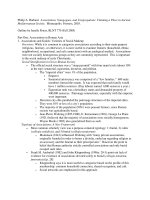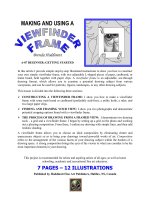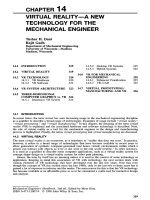Tài liệu Allergic and Non‐Allergic Sinusitis for the Primary Care Physician: Pathophysiology, Evaluation and Treatment pdf
Bạn đang xem bản rút gọn của tài liệu. Xem và tải ngay bản đầy đủ của tài liệu tại đây (1.32 MB, 156 trang )
AllergicandNon‐AllergicSinusitisforthePrimaryCarePhysician:
Pathophysiology,EvaluationandTreatment
DanielG.Becker,MD
ClinicalAssociateProfessor
DepartmentofOtolaryngology‐HeadandNeckSurgery
UniversityofPennsylvania
Philadelphia,Pennsylvania
SamuelS.Becker,MD
ClinicalInstructor,
VanderbiltUniversity
ClinicalAssistantProfessor
DepartmentofOtolaryngology‐HeadandNeckSurgery
UniversityofPennsylvania
Philadelphia,Pennsylvania
Copyright©2110,DanielG.
Becker,MDandSamuelS.Becker,M.D.
Allrightsreserved
2
AllergicandNon‐AllergicSinusitisforthePrimaryCarePhysician:
Pathophysiology,EvaluationandTreatment
TABLEOFCONTENTS
INTRODUCTION
Chapter 1:
ANATOMY AND PHYSIOLOGY WITH SINUSITIS
OVERVIEW
Chapter 1:
Questions
Chapter 2:
SINUS SIGNS AND SYMPTOMS
Chapter 2:
Questions
Chapter 3:
MAKING THE DIAGNOSIS
Chapter 3:
Questions
Chapter 4:
ALLERGIC RHINITIS
Chapter 4:
Questions
Chapter 5:
ASTHMA AND SINUSITIS
Chapter 5:
Questions
Chapter 6:
ACID REFLUX AND SINUSITIS
Chapter 6:
Questions
Chapter 7:
SNORING
Chapter 7:
Questions
Chapter 8:
UNUSUAL CAUSES OF SINUSITIS
Chapter 8:
Questions
Chapter 9:
SINUSITIS IN PATIENTS WHO HAVE HAD SURGERY
Chapter 9:
Questions
Chapter 10:
MEDICAL TREATMENT OF SINUSITIS
Chapter 10:
Questions
Chapter 11:
SURGICAL TREATMENT OF SINUSITIS
Chapter 11:
Questions
Chapter 12:
SURGERY OF THE SEPTUM, THE TURBINATES, AND
OTHER "NON-SINUS" CAUSES OF NASAL BLOCKAGE
Chapter 12:
Questions
3
AllergicandNon‐AllergicSinusitisforthePrimaryCarePhysician:
Pathophysiology,EvaluationandTreatment
INTRODUCTION
SinusitisisoneofthemostcommonhealthcarecomplaintsintheUnitedStates.(1‐9)Approximately1in8
peopleintheUnitedStateswillhavesinusitisatonetimeintheirlives.TheNationalCenterforDiseaseStatistics
reportsthatsinusitisisnowthenumberone
chronicillnessforallagegroupsintheUnitedStates.The1993National
HealthInterviewSurveyfoundthatsinusitiswasthemostcommonlyreportedchronicdisease,affecting
approximately14%oftheUnitedStatespopulation.(2)Sinusdiseaseaffectsroughly31millionpeopleannually.
Between1990and1992,reportsindicatedthatsinusitissufferers
hadapproximately73milliondaysofrestricted
activity—a50%increasefrom4yearsearlier.(3)
Sinusitisaccountedfornearly25millionphysicianofficevisitsintheUnitedStatesin1993and1994.(3)(Of
course,manymorecasesareunreported,andmanypatientssufferwithoutseeingaphysician,so
thetrueincidence
ofsinusitisisunknown.)Althoughtheyaretypicallynotseriousandrespondpromptlytopropermedicaltreatment,
inflammatorydiseasesofthesinusesarealeadingcauseoflossofproductivitybothatworkandatschool.An
estimated32.3millionpeopleintheUnitedStateshavechronicsinusitis.
(3)Furthermore,10%ofthepopulation
suffersfromallergicsinusdisease.(3)Thecostoftreatingsinusdiseaserunsintothebillionsofdollars,without
takingintoaccountlossofwork.Giventhetrendtowardrationedmedicalcare,physiciansareincreasinglyworking
towardaneffectivemeansofbothearly
diagnosisandfollowupinthesepatients.Untilrecently,sinusitishasbeen
anundertreateddisease.Itsdrasticnegativeeffectonqualityoflifehasbeengenerallyunderappreciatedand
unrecognized.
Recentstudiesshowthatpatientsscoretheeffectsofchronicsinusdiseaseinareassuchasbodilypainand
socialfunctioningas
moredebilitatingthandiseasessuchasangina,congestiveheartfailure,emphysema,chronic
bronchitis,andlowerbackpain,tonamejustafew.(2‐3)Itisestimatedthat2.2billiondollarsisspentyearlyon
4
prescriptionandnonprescriptionmedication.(4)Overallhealthexpendituresforsinusitisin1996wereestimatedat
approximately5.8billiondollars,with1.8billionofthatbeingspentonchildren12yearsandyounger.(5,6,7)In
thepast,manypatientsweretoldtheywouldjusthaveto“livewithit.”
Sincetheintroductionofendoscopic
techniquesfordiagnosisofsinusdiseaseintheUnitedStatesin1985,increasedattentionhasbeendirectedtothis
problem.Medicaltherapymayberecommendedinthefaceofnasalsymptomsandmucosaldisease.Typical
medicationsusedinthetreatmentofmucosaldiseaseincludeoral
antibiotics,steroids,mucolytics,nasalsteroid
spray,nasalsalinespray,oraldecongestants,andoralantihistamines.Theselectionofappropriatemedications
dependsuponthedeterminationofthediagnosis.Forexample,manytimesantibiotics areprescribedwithoutfirst
obtainingasinusculture.Inadequatedurationandbreadthoftreatmentmayresultinpersistentandrecurrent
symptoms,andalsointhedevelopmentofresistantbacteria.
Anumberoffactorsarefelttobeimportantintheincreasingincidenceofsinusitis.Inhaledallergensand
irritatingairpollutantsaredetrimentaltothesinusesandareontherise.Globalwarmingandtherelatedincreases
inairpollutionalso
affectthesinuses.Cigarettesmokeisalsodetrimentaltothesinuses,notonlyforthesmokers,
butalsothoseexposedtosecondhandsmoke.Whiletheincidenceofsinusitisisontherise,therehavealsobeen
enormousimprovementsinthepast15yearsintheabilitytodiagnoseandtreat
theseproblems.Thisislargely
becauseoftechnologicaladvancesinnasalendoscopyandX‐rayimaging.Also,thedevelopmentofnewer,more
powerfulmedicationsincludingnewantibiotics,antihistamines,andothers,andsignificantadvancesinsurgical
treatmenthaveplayedamajorroleinimprovedpatientcare.
Sinusitisisthemostcommonchronic
healthcareconditionintheUnitedStates,anditsincidenceis
increasing.Fortunately,therehavebeensignificantadvancesinthediagnosisandtreatmentofthisproblem.This
CMEactivityrespondstothecontinuingneedofpracticingphysicianstoupdatetheirknowledge.ThisCMEactivityis
designedtoprovideprimarycare
physicianswiththemostup‐to‐dateinformationaboutallergicandnon‐allergic
sinusitisanditstreatment.
5
REFERENCES
1.MelenI.Chronicsinusitis:clinicalandpathophysiologicalaspects.ActaOtolaryngolSuppl(Stockh)1994;515:45‐
48.
2.GliklichRE,MetsonR.Thehealthimpactofchronicsinusitisinpatientsseekingotolaryngologiccare.Otolaryngol
HeadNeckSurg1995;113:104–109.
3.GliklichRE,HilinskiJM.Longitudinalsensitivityofgenericand
specifichealthmeasuresinchronicsinusitis.Qual
LifeRes1995:4:27–32.
4.Gliklich,RE,MetsonR.Thehealthimpactofchronicsinusitisinpatientsseekingotolaryngologiccare.Otolaryngol
HeadNeckSurg1995;113:104–109.
5.RayNF,BaraniukJN,ThamerM.Directexpendituresforthetreatmentofallergicrhinoconjunctivitisin1996,
including
thecontributions ofrelatedairwayillnesses.JAllergyClinImmunol1999;103:401–407.
6.RayNF,BaraniukJN,ThamerM.Healthcareexpendituresforsinusitisin1996;contributionsofasthma,rhinitis,
andotherairwaydisorders.JAllergyClinImmunol1999;103:408–414.
7.PankeyGA,GrossCW,MendelsohnMG.ContemporaryDiagnosis
andManagementofSinusitis.NewtownPA:
HandbooksinHealthCare,2000.
8.DereberryJ,MeltzerE,NathanRA,StangPE,CampbellUB,CorraoM,StanfordR.OtolaryngolHeadNeckSurg,
2008Aug;139(2):198‐205.RhinitissymptomsandcomorbiditiesintheUnitedStates:burdenofrhinitisinAmerica
survey
9.KennedyDW,
BolgerWE,ZinreichSJ.DiseasesoftheSinuses:DiagnosisandManagemet,London:BCDecker,2001
6
AllergicandNon‐AllergicSinusitisforthePrimaryCarePhysician:
Pathophysiology,EvaluationandTreatment
CHAPTER1
SINUSANATOMYANDPHYSIOLOGYWITHSINUSITISOVERVIEW
DEFINITIONS
Thesinusesarechambersinthebonesofthefaceandskullthatarenormallylinedwithathinmucus
producingmembrane(calledmucosa).Therearefourpairedparanasalsinuses—themaxillary,ethmoid,frontal,and
sphenoidsinuses(Fıg.1).They
communicatewiththenasalcavityvianarrowopenings.Airandmucusenterandexit
thesinusthroughtheseopenings.Blockageofthesmallopeningsfromswelling(causedbyinfection, allergy,and
othercauses)canresultinsinusitis.(1,2,3)
SINUSITIS
Sinusitisliterallymeans“i nflammationofthesinuscavities.”(4‐6)
Thisinflammationiswhathappensoccurs
whenapatient’snoseandsinusesareexposedtoanythingthatmightirritatethemembranouslinings.These
irritantsmayincludedustandpollution,cigarettesmoke,andotherirritants.Allergicreactiontomold,pollen,and
soforthmayalsoirritatethenasallinings.Furthermore,infection
byavirusorbacteriamayirritatethenasallinings.
Theswellingthatoccursmaycausethenarrowopeningsinthenoseandsinuscavitiestonarrowevenfurtheror
eventoshutcloseentirely.Thickabnormalmucussecretionscanalsoblockthesinuses further.
Rhinitisreferstoinflammationofthenasal
mucosalliningsonly.Sinusitisreferstoinflammationofthe
mucosalliningsofthesinusesandisusuallyassociatedwithandoftenprecededbyrhinitis.Becausethetwogo
together,ear,nose,andthroatspecialiststodayoftenusethetermrhinosinusitis.However,thewordsrhi nitis,
sinusitisandrhinosinusitisareoftenused
interchangeably.Inthisarticle,wewillusethetermsinusitistomean
inflammationofthesinusandnasalpassageways.Expertsonsinusitishavetriedtopreciselydefinesinusitis.The
RhinosinusitisTaskForceoftheAmericanRhinologicSocietyhasdefinedrhinosinusitisasaconditionmanifestedby
aninflammatoryresponseinvolvingthe
mucousmembranesofthenasalcavityandparanasalsinuses,fluidswithin
thecavities,and/orunderlyingbone.(4‐6).
7
Symptomsassociatedwithrhinosinusitisincludenasalobstruction,nasalcongestionanddischarge,post‐
nasaldrip,facialpressureandpain,cough,andothers.(Table1).Astronghistoryconsistentwithchronicsinusitis
includesthepresenceoftwoormoremajorfactorsoronemajorandtwominorfactorsforgreaterthan12
weeks.
(4‐6).
TABLE1:FactorsAssociatedwiththeDiagnosisofChronicRhinosinusitis
Majorfactors
Minorfactors
Facialpain/pressure* Headache
Facialcongestion/fullness Fever
Nasalobstruction/blockage Halitosis
Nasaldischarge/purulence/discolorednasaldrainage Fatigue
Hyposmia/anosmia Dentalpain
Purulenceinnasalcavityonexamination Cough
Earpain/pressure/fullness
*Facialpain/pressurealonedoesnotconstituteasuggestivehistoryforchronicrhinosinusitisintheabsenceof
anothermajornasalsymptomorsign.
ANATOMY
Sinusdevelopmentcontinuesthroughoutchildhood,andisusuallycompletebyadolescence(Figure1).(1,2)
Mostpeoplehavealleightsinusespresentbythistime,althoughinaminorityofpatientssomeofthesinusesdo
notfullyform.Thesehypoplastic(incompletelyformed)oraplasticsinuses(completelyunformed)areoftenan
incidentalfinding,usuallynotassociatedwithanyincreasedsinusproblems,althoughinsomeins tancestheyshould
beaddressed.(7‐10)
8
FIGURE1–Coronal(upperillustration)andsagittal(lowerillustration)viewsintotheparanasalsinuses.
9
Thesinusescommunicatewiththenasalcavityvianarrowopeningscalledostia.(11)Ostiadrainintospaces
withinthenosecalledmeatiwhichareborderedbyverticallyorientedbonesknownasturbinates.Thetearduct
(naso‐lacrimalduct)drainsintotheinferiormeatus(whichisborderedbytheinferior
turbinatebone).Thisisone
reasonwhyournosedripswhenwecry.Themaxillary,frontal,andethmoidsinusesdrainintothemiddlemeatus,
whichisborderedbythemiddleturbinatebone(FIGURE2).Someoftheethmoidsinusesalsodrainintothe
superiormeatus,whichisaspacedefined
bysuperiorturbinatebone.Whilethemaxillary,frontal,andsphenoid
sinusesaresolitary,well‐definedcompartments,theethmoidsinusis–inactuality–acollectionofseveralsmall
sinuses,structuredlikeabeehive.Itisforthisreasonthattheethmoidsinuseshavevarieddrainagepatterns.The
sphenoidsinusdrains
intothespheno‐ethmoidalrecess,locatedbetweenthesuperiorturbinateboneandthenasal
septum.(3,11,12)
Airandmucusenterandexitthesinusthroughthesinusostia.Thefunctionsofthenoseandsinusesinclude
olfaction(senseofsmell),respiration,anddefense.(3,11,12)
Thenoseandsinusesproducemucustokeepthe
nasalandupperrespiratorypassagewaysmoist,andhaveaneffectonvocalresonance.Amongtheimportant
physiologicalrolesofthesinusesarethehumidificationandwarmingofinspiredair,andtheremovalofparticulate
matterfromthisair.Humidificationandwarmingof
inspiredairareaccomplishedbythewaterysecretionsofthe
serousglands,whichcanproduceupto1–2litersofsecretionsperday.
10
FIGURE2–Themaxillary,frontal,andethmoidsinusesdrainintothemiddlemeatus,whichisborderedbythe
middleturbinatebone.Theosteomeatalcomplex(OMC)istheGrandCentralStationofthesinuses.Anyprocess
thatcausesswellingandblockageofthiscriticalareacontributestothesymptomsof
sinusitis.
Whilethewateryseroussecretionsplayaroleinhumidificationandwarming,thesecretionsofthegoblet
cellsandmucousglandsfacilitatetheremovalofparticulatematter.Thismucous is veryeffective,trappingupto
80%ofparticleslargerthan3–5microns.(3)Thisincludesnotonlyinorganicpathogens
butalsoupto75%ofthe
bacteriaenteringthenose.(3)Themucousblanketofthenoseisaverydynamicstructure,continuouslyrenewing
itselfevery10–20minutes.(3)Themucousblanketalsodefendsthebodyagainstinfection.Besidestrappingorganic
pathogens,theblanketconstitutesarichimmunologicbarrier
withinthemucosa.Whenexposedtothetrapped
antigens,itcanfurtherenhancetheresponsebystimulatingtheimmunesystem.Theciliatedepitheliumcontinually
beats,propellingthemucusinasynchronizedfashiontowardthenaturalopeningorostiumofeachsinus.These
ostiadrainintothenasalcavity.Themucusis
thenpropelledtothenasopharynxtobeswallowed.Atthispointthe
acidsecretionsofthestomachcan helpdestroytheinhaledpathogens.(3,11‐13)
11
Thenormalfunctionofthesinusesdependsonthreeessentialcomponents:thinnormalmucussecretions,
normallyfunctioningmicroscopichairs(calledcilia)thatmovethemucusoutofthesinuses,andopensinusdrainage
openings(calledsinus ostium).Thesecomponentsallowforthecontinuousclearanceofsecretions.I nterference
withanyof
thesethreecomponentsofthenormalsinuses maypredisposethepatienttosinusitis.Inotherwords,
thicksecretionsmalfunctionofthemicrohairs,orblockageofthenaturalsinusopeningsmayleadtosymptomsof
sinusitis.Themicrohairsmoveatafrequencyof10strokespersecondinacoordinatedfashion.
Theactionofthese
microhairsmoveanygivenmucusparticlefromthesinusesandoutintothenoseinabout10minutes.Ciliafunction
ismosteffectiveatatemperatureabove18°Candarelativehumidityofabout50%.(3)Thismaybeafactorwith
commoncolds,whichoccur
inthewintermonths.Forthemucociliarysystemtoclearthesecretionsfromthe
sinuses,thenaturalsinusopeningsmustbepatent.(14)
PHYSIOLOGYOFSINUSITIS
Thegrandcentralstationofmucociliaryclearanceistheosteomeatalcomplex.(FIGURE2).(3‐6,15‐17)
Whenariverisdammed,
waterflowisslowedorhaltedandwatergathersbehindthedam.Thewa terlevelrises
andareservoirforms.Similarly,iftheosteomeatalcomplexisblocked,abackupofmucusoccurs.Thiscanleadtoa
conditionthatleadstoinfection.Bacterialiveinthenoseandsinuses;however,
inaninfectiousstatesomesubset(s)
ofbacteriahavereproducedoutofproportiontoothers.Thisbacterialovergrowthisoftenpresentinsinusitis–
particularlyacutesinusitis.Anyprocessthatcausesmucosalinflammationintothesensitiveareaofthe
osteomeatalcomplex(OMC)canoccludetheothersinusesthatdrainintothis
crossroadzone.(16‐20)
Blockageofthesmallopeningsfromswelling(causedbyinfection,allergy,andothercauses)canalsoresult
insinusitis.Whenobstructionoccurs,themucusisretainedinthesinuscavity.Thesestagnantsecretionsthicken
andprovideamediumforbacterialgrowth.Obstructionalsoimpairsaeration
andgasexchangewithinthesinus
cavity.Absorptionoftrappedoxygenleadstohypoxiaordecreasedoxygenlevelswithinthesinus,which
exacerbatessinusitis.Thesechangesleadtodamageanddysfunctionoftheciliaandepithelium.Theretained
secretionsandinfectionleadtofurthertissueinflammation,whichinturnleads
tofurtherblockage.Thesechanges
12
maybereversiblewithappropriatemedicaland‐ifneeded‐surgicalmanagement.Onoccasion,surgeryisneeded
toallowrestorationofnormalmucosallining.Inthesecases,surgeryallowsforrestorationofnormalsinusaeration
andmucociliaryclearance .(21‐23)
Animportantgoalofanytreatmentforsinusitisisto
breakthe“viciouscyle.”Thisphrasereferstothefact
thatonceapatientdevelopssinusitis,itmaypersistandworseninadownwardspiralingcycle..Swellingleadsto
moreobstruction,whichleadstomoreswelling,andsoon.Inotherwords,ifswellingcausesnarrowingofa
patient’s
sinusoutflowtracts,thentheycanmalfunction.Thedrainageofmucusisimpaired,andthepatient’s
mucussecretionscanstagnateandthicken.Themucusinthenoseandsinusescanalsodevelopinfectionifithas
difficultydrainingfromthenoseandsinuses.Infectioncausesevenmoreswelling,compoundingtheproblem
and
causingthesinusestospiraldownwardintheviciouscycle.Itisforthisreasonthattreatmentsshouldbetargeted
andfocused–tobreakthe“viciouscycle.”
ANATOMICALABNORMALITIESANDSINUSITIS
Asnotedabove,chronicsinusitisis–for themostpart–amucosaldiseaseofthe
sinonasallining.
(3,11,16,17,20‐23)
Whilenon‐anatomicirritantssuchasinhaledallergens,chemicalirritants,andsmokemaystartthiscycleof
mucosalswelling,therearealsoanatomicalabnormalitiesthatmaycontributetothisprocess.Thesearediscussed
below.
Thenasalseptumdividestherightandleftnasalcavities.The
septumiscomprisedofbothboneand
cartilagewithamucosallining,andsitsroughlyinthemidlineofthenose.Itisnotuncommonforthenasalseptum
tobeslightlydeviated.Insomeinstances,however,thisseptaldeviationmaybesignificant.Severeseptaldeviation
willnotonlycausenasal
obstructionbyblockingtheairflowintotheaffectedside,butmayalsoimpactmucociliary
clearanceby“pushing”themiddleturbinateandotherstructurestowardstheinfundibulumleadingtoimpairment
ofthissinusdrainageoutflowtract(FIGURE3).(3,11,12,24‐25)
13
FIGURE3A–CoronalCTscanofthesinusesdemonstratingseptaldeviationtowardsthepatient’srightside.The
ostiomeatalcomplexisswollenandblocked.
FIGURE3B–ThisisacoronalCTscanofthesinusesofanotherpatientdemonstratingseptaldeviationtowardthe
patient’srightside.Theostiomeatalcomplexisswollenandblocked.
Themiddleturbinateisanormalstructurethatprovidesthemedialboundaryforthemiddlemeatus–
wherethemaxillary,
ethmoid,andfrontalsinusesdrain.Aparadoxicallycurvedmiddleturbinatemaypushagainst
theinfundibulumblockingthesinusoutflowpathway.Aconchabullosa,orairfilledmiddleturbinate,(FIGURE4)
14
mayimpededrainageoftheinfundibulumonitsownsideofthenoseor,inextremecircumstances,maypushthe
septumtotheoppositesideofthenoseandblockdrainage onthatside.(24‐25)
Sinonasalpolypsarepresentinasmallpercentageofpatientswithsinus
disease.Bytheirsheermasseffect
andlocation–oftenwithinthemiddlemeatus –thesepolypsimpedesinusdrainageandmucociliaryclearance,
therebycontributing tothe“viciouscycle.”Ofcoursethepolypsare,themselves,productsofinflammationso
furthersinusinflammationjustleadstopersistentpolypswhichareincreasedin
size(FIGURE5).(25)
OTHERCAUSATIVEFACTORSINSINUSITIS
Causativefactorsinsinusitiscanbeconsideredbyca tegories.
Inflammatoryfactorsincludeupperrespiratorytractinfections(example,thecommoncold),allergicrhini tis,
vasomotorrhinitis,recentdentalwork,barotrauma,andswimming.
Systemicfactorsincludeimmunodeficiency,ciliarydyskinesiasyndrome,cystic
fibrosis,rhinitisofpregnancy,
andhypothyroidism.
Mechanicalfactorsincludechoanalatresia,sinonasalpolyps,deviatedseptum,foreignbody,trauma,tumor,
nasogastrictube,turbinatehypertrophy,conchabullosa,adenoidhypertrophy.
Medicativecausesincludebeta‐blockers,birthcontrolpills, antihypertensives,aspirinintolerance,rhinitis
medicamentosa(overuseoftopicaldecongestants),andcocaineabuse.Manyof
thesecauseswillbe
discussedbelow.(3,26‐29)
15
FIGURE4–Anair‐filledleft‐sidedmiddleturbinate(conchabullosa)pushesagainstthepatient’snasalsidewall
andblocksthesinusdrainageoutflowpathway.
FIGURE5–ThiscoronalCTofapatientwithpolypsshowssignificantblockageofthenasalairway,aswellasthe
sinuses.Thepatientalsohasaseptaldeviation.
16
REFERENCES
1.HengererAS.Embryologicdevelopmentofthesinuses.EarNoseThroatJournal.1984;63(4):134‐136.
2.SargiZB,CasianoRR.“Surgicalanatomyoftheparanasalsinuses.”InRhinologicandSleepApneaSurgical
Techniques.SpringerBerlinHeidelberg.2007.
3.StammAC,DrafW.Micro‐endoscopicsurgeryoftheparanasalsinusesandskullbase.Springer‐Verlagpublishers,
Berlin,2000.
4.StammbergerHR,KennedyDW.Paranasalsinuses:anatomicterminologyandnomenclature.TheAnatomic
TerminologyGroup.AnnOtolRhinolLaryngolSuppl.1995;167:7‐16.
5.LanzaDC,Kennedy
DW.AdultRhinosinusitisDefined.OtolaryngolHeadNeckSurg1997;117:51‐57.
6.ShapiroGG,RachelefskyGS.IntroductionanddefinitionofSinusi tis.J AllergyCLinImmunol1992;90:417‐418.
7.BolgerWE,WoodruffWW,MoreheadJ,ParsonsDS.“Maxillarysinushypoplasia:classificationanddescriptionof
associateduncinateprocesshypoplasia.”OtolaryngolHeadNeckSurg.1990;103(5):759‐
65.
8.TasarM,Cankal
F,Bozlar
U,etal.“Bilateralmaxillarysinushypoplasiaandaplasia:radiologicalandclinical
findings.”DentomaxillofacialRadiology.2007;36:412‐415.
9.EggesboHB,SovikS,DolvikS,etal.“CTcharacterizationofdevelopmentalvariationsoftheparanasalsinusesin
cysticfibrosis.”Actaradiologica.2001;42(5):482‐493.
10.KapoorPKD,KumarBN,WatsonSD.“Maxillary
SinusHypoplasia.”JLaryngolOtol.2002;116:135‐137.
11.WormaldPJ.Endoscopicsinussurgery:anatomy,three‐dimensionalreconstruction,andsurgicaltechnique.
Thiememedicalpublishers,NewYork,2007.
12.RiceDH,SchaeferSD.Endoscopicparanasalsinussurgery.3
rd
edition.LippincottWilliamsandWilkins.
Philadelphia,2003.
13.YangP,LiuT,WangC,etal.“Activeionsecretionandpermeabilityofrabbitmaxillarysinusepithelium,impactof
staphylococcalenterotoxinB.”Otolaryngol‐HeadNeckSurg.2000;123(1):120‐123.
14.AlhoO.“NasalAirflow,MucociliaryClearance,andSinusFunctioningDuringViralColds:Effects
ofAllergic
RhinitisandSusceptibilitytoRecurrentSinusitis.”AmJRhinol.2004;18(6):349‐355.
15.DykewiczM.“Rhinitisandsinusitis.”JAllergyClinImmunol.2004;111(2):520‐529.
16.LaineFJ,SmokerWR.Theostiomeatalunitandendoscopicsurgery:anatomy,variationsandimagingfindingsin
inflammatorydiseases.AJRAmJRoentgenol.1992;159:849‐57.
17.
HamdanAL,AhmadH,YounesA,etal.“Theetiologicroleoftheosteo‐meatalcomplexinthepathogenesisof
sinusitis:aretrospectivestudyofclinical,CTandendoscopic findingsin143patients.”JMedLiban.
2001;49(6):329‐
32.
18.WallaceR,SalazarJ,CowlesS.“Therelationshipbetween frontalsinusdrainageandosteomeatalcomplex
disease:aCTstudyin217patients.”AmJNeuroradiol.1990;11(1):183‐186.
17
19.deFreitasLinharesRielloA;Boasquevisque E.Anatomicalvariantsoftheostiomeatalcomplex:tomographic
findingsin200patients.RadiolBras.2008;41(3):
20.ScribanoE,AscentiG,LoriaG,etal.Theroleoftheostiomeatalunitanatomicvariationsininflammatorydisease
ofthemaxillarysinuses.EurJRadiol.19 97;24:172
‐4.
21.WaguespackR.“Mucociliaryclearancepatternsfollowingendoscopicsinussurgery.”Laryngoscope.1995;
105(2):1‐40.
22.MyllerJ,Toppila‐Salmi S, TorkkeliT,etal.“Effectofendoscopicsinussurgeryonantralmucociliarycle arance.”
Rhinology.
2006;44(3):193‐6.
23.BoatsmanJ,CalhounK,RyanM.“RelationshipBetweenRhinosinusitisSymptomsandMucociliaryClearance
Time.”OtolaryngolHeadNeckSurg.2006;134(3):491‐493.
24.BeckerDG.SeptoplastyandTurbinateSurgery.AestheticSurgJ2003;23:393‐403.
25.CookPR,BegegniA,BryantC,DavisWE.Effectofpartialmiddleturbinectomyon
nasalairflowandresistance.
OtolaryngolHeadNeckSurg1995;113:413‐419.
26.PankeyGA,GrossCW,MendelsohnMG.ContemporaryDiagnosisandManagementofSinusitis.NewtownPA:
HandbooksinHealthCare,2000.
27.FacerGW,KernEB.Sinusitis:currentconceptsandmanagement.In:BaileyBJ,editor.HeadandNeckSurgery–
Otolaryngology.Philadelphia,PA:
JBLippincott,1993.
28.ReulerJB,LucasLM,KumarKL.Sinusitis.Areviewforgeneralists.WestJMed1995;163:40–48.
29.StammbergerH.FunctionalEndoscopicSinusSurgery.Philadelphia,PA:BCDecker,1991.
18
AllergicandNon‐AllergicSinusitisforthePrimaryCarePhysician:
Pathophysiology,EvaluationandTreatment
CHAPTER1
QUESTIONS
1.Sinusitis‐“inflammationofthesinuscavities”‐maybeduetoallofthefollowingEXCEPT:
A. dustandpollution,andotherirritants.
B. CigaretteSmoke
C. Allergicreactiontomold,pollen,and soforth.
D. infectionbyavirusorbacteria.
E. StructuralBlockagesuchasa
deviatedseptum
2.SystemicfactorsinsinusitisincludeallbutthefollowingEXCEPT:
A. Ciliarydyskinesiasyndrome
B. Cysticfibrosis
C. RhinitisofPregnancy
D. Hypothyroidism
E. RhinitisMedicamentosa
3.MedicativeFactorsinsinusitisincludeallofthefollowingEXCEPT:
A. BetaBlockers
B. BirthControlPills
C.
Antihypertensives
D. Aspirin
E. Synthroid
4.Thesecretionsofthegobletcellsandmucousglandsfacilitatetheremovalofparticulatematter.Thismucousis
veryeffectivefor,
A. trappingupto80%ofparticleslargerthan3–5microns.
B. trappingupto95%ofparticleslargerthan1‐3
microns
C. trappingupto60%ofparticleslargerthan3‐5microns
D. trappingupto80%ofparticleslargerthan1‐3microns
E. trappingupto85%ofparticleslargerthan1‐3microns
5.WhichofthefollowingstatementsisTRUEregardingthemucousblanketof
thenose
A. Itcontinuouslyrenewsitselfevery10–20minutes.
B. Itcontinuouslyrenewsitselfevery30‐60minutes.
C. Itcontinuouslyrenewsitselfevery6‐8hours.
D. Itcontinuouslyrenewsitselfdaily.
E. Itcontinouslyrenewsitselfevery1‐3days
19
AllergicandNon‐AllergicSinusitisforthePrimaryCarePhysician:
Pathophysiology,EvaluationandTreatment
CHAPTER2
SIGNSANDSYMPTOMSOFSINUSDISEASE
SinusitisisoneofthemostcommonhealthcarecomplaintsintheUnitedStates.(1‐8)Approximately1in8
peopleintheUnitedStateswillhavesinusitisatonetimeintheirlives.TheNationalCenterforDiseaseStatistics
reports
thatsinusitisisnowthenumberonechronicillnessforallagegroupsintheUnitedStates.The1993National
HealthInterviewSurveyfoundthatsinusitiswasthemostcommonlyreportedchronicdisease,affecting
approximately14%oftheUnitedStatespopulation,andAnandreporteda16%incidenceinhis2004
study.(9)A
2006studybyKoyandCoonsontheincidenceofchronicconditionsreportedthatapproximatelythree‐fifths
(62.5%)ofthestudysamplereportedatleastoneof18chronicmedicalconditions;sinusitis(24.8%)wasthemost
commonlyreportedcondition,followedbyhypertension(23.5%)andarthritis(21.5%).(
10)
Sinusdiseaseaffectsroughly31millionpeopleannually.Furthermore,10%ofthepopulationsuffersfrom
allergicsinusdisease.Between1990and1992,reportsindicatedthatsinusitissufferershadapproximately73
milliondaysofrestrictedactivity—a50%increasefrom4yearsearlier.Sinusitisaccountedfornearly25million
physicianoffice
visitsintheUnitedStatesin1993and1994.(Ofcourse,manymorecasesareunreported,andmany
patientssufferwithoutseeingaphysician,sothetrueincidenceofsinusitisisunknown.)Althoughtheyaretypically
notseriousandrespondpromptlytopropermedicaltreatment,inflammatorydiseasesofthesinusesare
aleading
causeoflossofproductivitybothatworkandatschool.
RhinosinusitisposesanimmenseeconomicburdenintheUnitedStates.(9)Thecostoftreatingsinus
diseaserunsintothebillionsofdollars,withouttakingintoaccountlossofwork.Overallhealthcareexpenditures
attributableto
sinusitisin1996wereestimatedat$5 .8 billion,ofwhich$1.8billion(30.6% )wasforchildren12years
oryounger.(5‐7)Aprimarydiagnosisofacuteorchronicsinusitisaccountedfor58.7%ofallexpenditures($3.5
billion).(5‐7)Itisestimatedthat2.2billiondollarsisspentyearly
onprescriptionandnonprescriptionmedication.
(5‐7)About12%eachofthecostsforasthmaandchronicotitismediaand eustachiantubedisorderswere
20
attributedtodiagnosisandtreatmentofcomorbidsinusitis.(5‐8)Nearly90%ofallexpenditures($5.1billion)were
associatedwithambulatoryoremergencydepartmentservices.(9,11)
Untilrecently,sinusitishasbeenanundertreateddisease.Itsdrasticnegativeeffectonqualityoflifehas
beengenerallyunderappreciatedandunrecognized.Recent
studiesshowthatpatientsscoretheeffectsofchronic
sinusdiseaseinareassuchasbodilypainandsocialfunctioningasmoredebilitating than diseasessuchasangina,
congestiveheartfailure,emphysema,chronicbronchitis,andlowerbackpain,toname justafew.(2‐3)
Thesymptomsofsinusitisinclude
nasalblockage(themostcommonsymptom),facialpressureorpain,
snoring,postnasaldrainageandbadbreath,fatigue,recurrentinfections,amongothers(12‐16)(Table1).Inthis
chapter,wegivedetailedconsiderationtothesignsandsymptomscommonlyassociatedwithsinusproblems.
TABLE1:FactorsAssociatedwiththeDiagnosis
ofChronicRhinosinusitis
MajorfactorsMinorfactors
Facialpain/pressure* Headache
Facialcongestion/fullness Fever
Nasalobstruction/blockage Halitosis
Nasaldischarge/purulence/discolorednasaldrainage Fatigue
Hyposmia/anosmia Dentalpain
Purulenceinnasalcavityonexamination Cough
Earpain/pressure/fullness
*Facialpain/pressurealonedoesnotconstituteasuggestivehistoryforchronicrhinosinusitisintheabsenceof
another
majornasalsymptomorsign
NASALBLOCKAGE
Nasalblockagehasmanycauses.Itisconvenienttodividethemintocausesthataretreate dmedicallyand
causesthatrequiresurgicaltreatment.Medicalcausesincludethecommoncold(viralinfection—atemporary
cause),bacterialsinusitis,allergy,sensitivitytodust, smoke,pollution,andother
irritants.Surgicalcausesinclude
anatomicabnormalitiessuchasadeviatedseptum,nasalpolyps,obstructedsinusesthatdonotimprovewith
medication,over‐enlargedturbinates,obstructingadenoids,andothercauses.Sometimesscarringfromtraumaor
21
priornasalsurgerycancausenasalobstruction.(7,12‐16)ChronicnasalobstructionmustbeevaluatedbyanEar
NoseandThroatspecialist.
SNORING
Therearemanycausesofsnoring,andoneofthemisnasalobstruction.Nasalobstructioncausesapatient
tobreathethroughthemouth,which
causesgreatervibrationofthetissueinthebackofthemouthandthroat
whensleepingandmayleadtosnoringorincreasedsnoring.Patientswhosnoreshouldcheckwithaspecialistto
findoutthecause.Ifitisbecauseofnasalblockage,anasaltreatmentmaybeindicated.Alternatively,
snoringmay
beasignofsleepapnea,especiallywhenassociatedwithwitnessedapneicperiodsanddaytimefatigue.(7,12‐16)
POSTNASALDRAINAGE
Postnasaldrainageisasymptomthatmayresultfromrhinitisorsinusitis.Abnormalswellingofthenasal
andsinusmembranescausesthemtoproducethick,
abnormalmucus,whichcancontributetonasalblockage,and
alsocandrainintothebackofthethroatandcausecough,sorethroat,andsoforth.Treatmentofpostnasal
drainageincludestreatingrhinitisandsinusitis.
Sometimes,thesensationofpostnasaldrainagemayactuallycomefromacidreflux.Acidfromthestomach
can
travelinaretrogradedirection–uptheesophagus–andontothevoicebox(larynx).Theirritationtothelarynx,
andassociatedthroat‐clearingandfeelingof“somethingstuckinmythroat”cancontributetothefeelingof
postnasaldrainage.AnEar,NoseandThroatdoctorcanquickly
andeasilyevaluateforthisLaryngopharyngealAcid
Reflux(seeChapter7)withaquickclinicalexaminationincludingflexiblenasopharyngolaryngoscopy.Inthiscase,as
inmostinstanceswiththesinusesand thethroat,effectivetreatmentdependsonproperdiagnosis!(7,12‐16)
HALITOSIS
Acommoncauseofhalitosis(badbreath)
isthickpostnasaldischarge.Thisthickmucuscanbewhite,yellow,
orevengreen.Ifapatienthassinusitis,themucusisstagnantinthesinusesandbecomesfoul‐smelling,itdripsback
intothethroattogivebadbreath.Nomouthwashwilltakethisbadbreathaway.Thepatient
needstoseeasinus
22
specialist.Aspartoftheevaluationofpostnasaldrainageandhalitosis,thespecialistwillevaluatethenoseand
sinuses,aswellasthethroat.(7,12‐16)
CHRONICCOUGHANDSORETHROAT
Coughisacommonpresentingsymptomofmanypatientsseeingaprimarycarephysi cian,andultimately
manyaresentforevaluationbysinusspecialists.Forpatientswithchroniccoughwhoarenonsmokers,ha venormal
spirometry,andarenotbeingtreatedwithanACEinhibitor,diagnosisusuallyfocusesondifferentiationbetween
postnasaldripsyndrome,asthma,gastroesophagealrefluxdisease,andnonasthmaticeosinophilicbronchitis,alone
orincombination.Patientswith
severeCOPDorGERDshouldbereferredtoappropriatespecialistsforthose
conditions.Themanagementofconditionscommonlytreatedbysinusspecialists(e.g.,allergicrhinitis,sinusitis)
followstherecommendationsofcurrentguidelinesand/orpracticeparameters.(17)
Twoofthemostcommoncausesofcougharepostnasaldripfromrhinosinusitis
andacidreflux
(laryngopharyngealreflux).Chronicproductivecoughinyoung adultsisveryoftenduetochronic rhinosinusitis(18).
Nonetheless,patientswithchroniccough,especiallyiftheysmoke,musthaveaspecialistexaminetheirlarynxto
evaluatethepossibilityoftumorormassofthelarynx.Thisonlytakesa
fewminutesandisdoneintheofficeunder
topicalanesthesiawithasmallflexibleendoscope.PatientswithchroniccoughshouldalsohaveachestX‐rayand
otherevaluationbytheirprimarycarephysician.Treatmentofthecauseofthecoughoftenimprovesorresolves
thepatient’stroublesomecough.
However,sometimesacoughcanpersistevenafterthecausehasbeentreated.
Re‐examinationisimportantwhenacoughpersists.However,thismaybethe“coughreflex.”Often,thisreflexmust
bebrokenbyacoughsuppressant.
Anassociatedsymptommaybeapersistentsorethroat.Aswithchroniccough,
persistentsorethroat
shouldbeevaluatedbyaspecialist.Ifthecauseisduetoallergicorotherirritation,treatmentisoften
straightforwardandeffective.Inothercasesthepresenceofamassneedstobeexcluded.Thiscanoftenbedone
withasimplecliniclarynge alexamination.(7,12
‐16)
23
FATIGUE
Patientswhoexperiencefatigueshouldseeth eirprimarydoctortoevaluatethemanypossiblecauses.
However,chronicsinusitis—likeanychro nicillness—cantakeitstollonapatient.Itcandecreaseenergylevelsand
maketheindividuallessproductive.Ifapatienthassinusitis,thiscanbea
contributingfactortofatigue.(7,12‐
16,19)
Chesterreportedtwocasesofsevereunexplainedfatiguewithmid‐facialpainandrhinitis.(19)Sinus
computerizedtomography(CT)findingswereminor,butbothrespondedtofunctionalendoscopicnasalsurgery
withresolution(Case1)ornearresolution(Case2)ofchronicfatigue.Possible
mechanismsweresuggestedlinking
nasaldiseaseandchronicfatigue,andincludereflexetiologyandsleepdisturbanceassociatedwithabnormalnasal
airflow.Chesterpointedoutthatchronicsinusitisistypicallynotconsideredby theprimarycarephysicianin
differentialdiagnosisoffatigue,andhesuggestedthatitshouldbeexploredas
acauseinunexplainedcases.(20)
Chesterandothersreportthatfatigueandbodilypainisclinicallyandstatisticallyimprovedbysinussurgery
inpatientswhofailedtorespondtomedicaltherapy.(21‐23)Patientswithseverefatigueshowedamore
pronouncedimprovementthanpatientslessseverelyfatigued.(22
)Significantlygreaterimpr ovementoccursin
patientswithfibromyalgiaandinpatientswhoaremoreseverelyfatiguedatpresentation, comparedtopatients
withmildfatigue.(22)
Soleretal(2008)reportthatnasalcongestion,fatigue,decreasedsenseofsmell,nasaldrainage,andfacial
pain‐pressureshowedsignificantandsustainable
postoperativeimprovementat3,6,12,and18monthsafter
surgery.(24)
Animportantconsiderationregardingfatigueismedicationuse.Someantihistaminesaresedating,andeven
non‐sedatingantihistamineshavebeenassociatedwithfatigueinsomestudies.(25‐26)BhattacharyyaandKepnes’
prospectivestudyfoundthathigherfatigue
symptomscoreswereassociatedwiththeuseofnon‐sedating
antihistamines,antibioticuse,butNOTwithintranasalsteroiduse.Theauthorsrecommendthatthelong‐termuse
ofnonsedatingantihistaminesbescrutinizedinpatientreportingsymptomsoffatigue.(26)
24
FACIALPAINANDHEADACHE
Facialpainandheadachehavemanycauses:tensionheadache,migraineheadache,stressheadache,cluster
headaches,reflexsympatheticdystrophy,andmore.Sinusitisdoescontributetofacialpressureandpain,anditcan
reduceresistancetootherkindsofheadaches—thatis,sinusitiscanlowerthepainthreshold
ormakethepatient
moredisposedtogetanothertypeofheadache.(7,12‐16)
ThecompleteandthoroughevaluationofheadacheincludesevaluationbyaneurologistandoftenanENT
specialist.Ifapatient’sdoctorfeelsthattheindividual’spainmaybemoresinusrelated,thedoctormaywant
to
startwithasinusspecialist,whowillexaminethepatientthoroughlyandwillsearchoutallofthemanycausesof
facialpainthatcanbetreated.
Ifthespecialistdoesn’tfindanythingdefinitive,theremaystillbehope ofothereffectivetreatment,anda
neurologistmayalsosuggest
treatments.
Inararepatient,ENTandneurologicexamfindsnocausefortheheadache.Inthesecases,apain
managementspecialistisenlistedintotheteam.Theinterventionsofthepainmanagementspecialist maybe
effectiveinselectedpatients.
Therelationshipbetweensinusdiseaseandheadacheiscomplicated.Phillipset
alundertookaprospective
studytoexaminethesuccessofendoscopicsinussurgeryforthealleviationofheadacheinadefinedgroupof
individuals.Inparticulartheywishedtodiscoverwhetherthepresenceofasthma,nasalpolyposisandpurulent
rhinosinusitisindicatedthatsurgicalinterventionachi eved anygreaterreliefofsymptoms
comparedtothose
withouttheseconditions.Overalltheyfoundasignificantimprovementinheadachesymptomsafterendoscopic
sinussurgery,butsubgroupanalysisofpatientswithorwithoutasthma,nasalpolyposisandpurulentrhinosinusitis
showednodifferencesbetweenthegroups.(27)
RECURRENTSINUSINFECTIONS
Somepatientshaverecurrentinfections.The
sinusspecialistmustfindoutwhytheygetrecurrentinfections
andtreatthisproblem.Somecausesareunavoidable—forinstance,patientswithsmallchildreninelementary
25
schoolwhobringhomecoldaftercoldwillhavetowaituntiltheirchildrengrowolder.(Although,eveninthis
situationthesinusspecialistcanoftenhelpwithpreventativemedicaltreatment.)Patientswithsinusblockage
predisposingthemtoinfectionsmayfindmedicaland/orsurgicaltherapytobehelpful.Thesinus
specialistmay
needtocheckthefunctionofthepatient’simmunestatus—whilethisisusuallynormal,occasionallyapatienthas
lowimmunedefensesthatcanbehelpedbydirectedtreatment.(7,12‐16)
ArelativeindicationforFESSisthepresenceofsignificantepisodesofrecurrentacutesinusitis.This
refersto
thesituationinwhichapatienthasrepeatedacutesinusinfectionsbutisrelativelysymptom ‐freebetweenthese
infections.RelativeindicationsforFESSexistinadultsandinchildrenover12whohaverecurrentacutesinusitis.
Whileeachpatient’ssituationisunique,generalguidelinesdoexistforsurgeryfor
recurrentacutesinusitis.These
guidelinesinclude(1)fourormoreepisodesofinfectionduringthepast12months;(2)atrialofimmunotherapyfor
allergicrhinosinusitisorabsenceofallergy;(3)presenceofananatomicvariant,especiallyonecausingOMC
obstruction;and/or(4)prophylacti cuseofnasalsteroids,mucolytics,and
decongestantswithoutbenefit.(15,16)
FACIALPAINANDPRESSUREWITHAIRTRAVEL
Nasalcongestionsecondarytosinusitisandotherconditions isarelativecontraindicationtoairtravel.This
meansthatpatientspronetonasalcongestivedisordersshouldonlytravelbyairplaneiftheyhavefirstconsulted
theirphysician.The
physicianmaydeterminethatitisnotsafetoflyormayfeelthatthepatientcanflywithproper
pretreatment.Therisksofflyingwithnasalcongestionincludeseverefacialpain,damagetotheeardrumsincluding
bleeding,perforation,hearingloss,dizzinessorvertigo,sinusbleeding.Thereisasmall
butrealriskofevenmore
seriousconditions,suchasneurologicalcomplications.
Itisrecommendedthatpatientswithnasalcongestiontakesystemicdecongestantandalsospraythenasal
passageswithatopicallong‐actingnasaldecongestantbeforedepartureandbeforedescent.Suchpatientsshould
checkwiththeirdoctorstomakesure
thattheycantakethesemedications–forinstance,apatientwithhighblood
pressuremayneedtoavoidthesemedications.Patientswithallergiesmayalsotakeanantihistamine,undera
doctor’ssupervision.Insomecases,adoctormaywishtoprescribeothermedications,suchasoralprednisone,a









